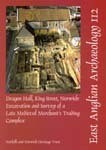
Format: Paperback
ISBN: 9780951787816
Pub Date: 31 Dec 2005
Series: East Anglian Archaeology Monograph
Illustrations: p, 25pls, 95figs;
Description:
When a wealthy merchant built Dragon Hall in 1427 there had already been stone buildings on the site for 140 years, while the origins of settlement here lay in the period c. 9751025. Some of the buildings used by these first settlers were uncovered during the recent work at Dragon Hall, along with evidence for a small riverside community within an extra-mural Late Saxon suburb.
Until the mid 13th century the site comprised three properties engaged in small-scale craft and industry, alongside horticulture and keeping livestock. At this time there appears to have been little interest in the commercial possibilities of the nearby river. By the early 1300s, however, the site had passed into the hands of the professional and ecclesiastical elite. The earliest known document relating to the site is a deed from 1289 which records a land transfer between the Abbey of Woburn and a Norwich clerk, John Page. Both used the site to build substantial stone houses. One reason for the abbeys interest in the property was probably its situation between a river flowing through the great medieval herring town of Yarmouth and a cardinal road through Norwich providing an ideal base from which to process fish and dispatch them inland. The early 14th-century remnants of Pages hall house survive today within Dragon Hall. The two holdings were conjoined during the second half of the 14th century, when the site was unified by the Midday or Clere families. In the late 1420s an ambitious construction programme commenced, probably by local merchant Robert Toppe, which resulted in Dragon Hall itself. The hall house was substantially rebuilt, and its service end embedded within the new trading hall. The first floor of the new hall provided the huge open space within which to store and display goods, and an office above the former service rooms from which to conduct business. The circulation of visitors was carefully regulated: divisions between public and private space are signalled by the quality of workmanship on show. A road which had linked the Midday/Clere complex to the street and river was now blocked by the warehouse and terminated beneath the first-floor showroom. After Toppes death the complex passed into the hands of local gentry until, in 1619, the great holding began to be sub-divided. Some of the buildings, including the abbey of Woburn's stone house, were demolished, and others rose in their place. A metalworking shop was eventually built on the site of one of the Woburn buildings and by the mid-18th century parts of the hall house were being used as an inn (The Three Merry Wherrymen, later the Old Barge Inn). By 1935 the site housed at least 34 individuals. As the population of the site rose so the quantity and variety of their discarded pottery increased. The collection of early modern ceramics from the site is currently without national parallel. Much of this came from the inns, as did four commemorative clay tobacco pipes stamped God Bless King George. Post-war King Street was briefly prosperous but the dwindling commercial use of the river initiated a decline in fortunes until by the early 1990s almost all commerce and industry had gone. Ongoing regeneration of the street reflects renewed interest in inner cities. At the point when Dragon Hall is once again looking forward to a sustainable future it is perhaps auspicious to be offering the definitive account of the sites first thousand years.

Format: Paperback
Pages: 399
ISBN: 9788779340053
Pub Date: 31 Dec 2005
Series: The Dolphin
Description:
What is human nature? How is language related to thought -- and should the connection be investigated socially or scientifically? Is external reality coherent or fragmented?
What are the foundations of rationality, and how trustworthy are they? Such questions have bedevilled thinkers for millennia. Contemporary scholars have harnessed enormous resources to find answers, yet their inquiry is invariably constrained by the tunnel vision of academic specialisation. This issue of The Dolphin seeks to establish common ground among the disciplines examining the mind–brain continuum. Among those meeting the editors' challenge to think outside the disciplinary box are Noam Chomsky, John Searle and Steven Pinker, as well as a dozen others from the fields of neuroscience, linguistics, philosophy, cognitive science, English, computer science and ethnography. The implicit framework that results should help researchers in all fields locate the diversity of human knowing within a joint ontological perspective.

Format: Hardback
Pages: 275
ISBN: 9781902937342
Pub Date: 15 Dec 2005
Series: McDonald Institute Monographs
Illustrations: 143 ills., 36 tables
Description:
How were early stone tools made, and what can they tell us about the development of human cognition? This question lies at the basis of archaeological research on human origins and evolution, and the present volume fulfils a growing need among advanced students and researchers working in this field. The individual chapters by a range of leading international scholars approach stone knapping from a multidisciplinary perspective that embraces psychology, physiology, behavioural biology and primatology as well as archaeology.
The skills and behaviour of humans and their primate relatives are key parts of the enquiry. The result is a better understanding of early human engagement with the material world and the complex actions required for the creation of stone tools. The book contains many illustrations and is extensively referenced, and provides a landmark contribution in this field.

Format: Paperback
Pages: 178
ISBN: 9780954557522
Pub Date: 01 Dec 2005
Illustrations: many col illus
Description:
Castle studies have been transformed in recent years with a movement away from the traditional interpretation of castles as static military structures towards a wider view of castles as aesthetic symbols of power, with a more complicated relationship with the landscape. Supported by numerous colour photographs of the most `tangible' remains of the Middle Ages, this clearly written and very accessible study makes the most current ideas about the role of the castle available to a wider and more general readership. Robert Liddiard discusses the history of castle building before and after the Norman Conquest, considering the Norman and medieval definition of the castle, and he reassesses the military defensive capabilities of castles, demolishing the idea that they were built in response to military policy.
Instead, they proved a very effective means for aristocrats to display their status. Liddiard evaluates the role of the castle in warfare and the extent to which sieges played a part in conflicts before turning his attention to the varied role of the castle in the landscape (and in the lives of those who lived in and around it) and its relationship to its environment, arguing that the aesthetic setting of many castles was not a happy accident. Throughout, the study is supported by numerous case studies which examine the archaeological, architectural and historical evidence for numerous castles.

Format: Hardback
Pages: 218
ISBN: 9781842171684
Pub Date: 05 Oct 2005
Series: Levant Supplementary Series
Description:
The eastern Mediterranean was the centre of trade for many centuries, sitting at the junction of what are now Europe, Asia and Africa. It was the place where exotic produce and products could be traded or exchanged for things that had their origins perhaps thousands of miles away. But wherever trade takes place, a similar exchange of ideas, technology and culture also occurs.
This book presents thirty papers on this very subject, looking at the ways in which we can measure the transmission of culture, and how this transmission varied across time and space.
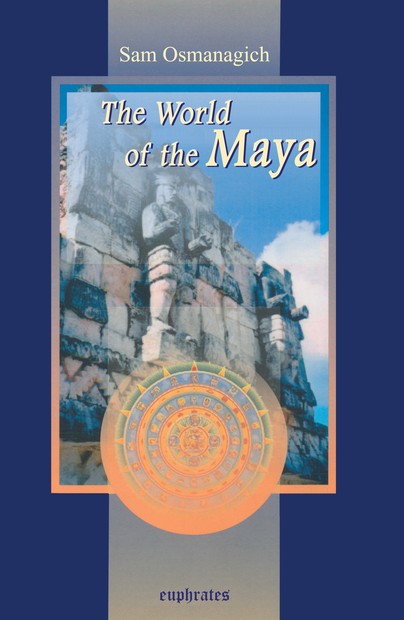
Format: Paperback
Pages: 272
ISBN: 9781593332747
Pub Date: 14 Sep 2005
Description:
Sam Osmanagich transports the reader to ruined Mayan cities including the brilliant Chichen Itza, elegant Uxmal, artistic Copan, magical Palenque, forgotten Ek Balam, beautiful Izamal, hidden Yaxchilan, spiritual Oxkintok, monumental Coba, and colossal Tikal.
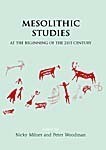
Format: Paperback
Pages: 224
ISBN: 9781842172001
Pub Date: 05 Aug 2005
Illustrations: 86 b/w illus and pls
Description:
The term 'Mesolithic' was born in the nineteenth century from the need to label a 'hiatus' period and was not generally accepted as a useful term by many scholars until around fifty years later. It has been championed by some, but still concerns others because of the difficulty of defining what it represents. This volume highlights the enthusiasm for Mesolithic studies in the 21st century and the feeling that there is a need to explore the many facets of Mesolithic lifeways.
Approaches are now moving away from the traditional Mesolithic canon that seems to have been based on a particular set of biological and/or ecological perspectives and are now looking for new directions and new theoretical arenas which can only help stimulate Mesolithic debate. The papers in this volume take a range of approaches to a period that has largely been devoid of explicit theoretical discussion. They deconstruct and explore a broad variety of subjects, including mobility, complexity, seasonality, death & burial, gender & sexuality, social relations, music, human agency, ethnoarchaeology and emotion.
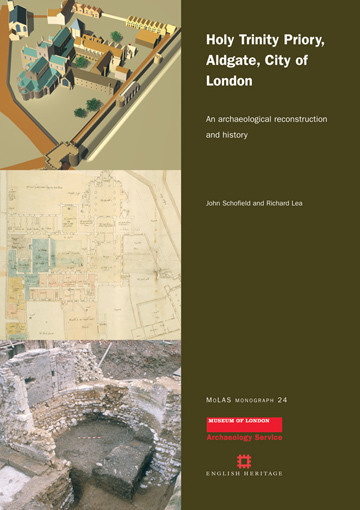
Format: Paperback
Pages: 285
ISBN: 9781901992458
Pub Date: 20 Jul 2005
Series: MoLAS Monograph
Illustrations: 214 b/w and col illus
Description:
This is an archaeological, architectural and historical study of one of the largest complexes of buildings in the medieval City of London, but one which is largely unknown and of which only two fragments survive above ground today. It is the fifth volume in a series on the monasteries of London. Holy Trinity Priory, Aldgate, was the first religious house to be established inside the walls of London after the Norman Conquest, in 11078; one of the earliest Augustinian houses to be established in England; and the first to be dissolved, in 1532.
By 1200 the precinct north of Leadenhall Street and just inside Aldgate was filled with imposing stone buildings, including a large and architecturally impressive church which was the burial place of two of the children of King Stephen in the middle of the 12th century. Londons first mayor, Henry FitzAilwin, was buried in the entrance to the chapter house. In the 16th century the monastery was owned by the Duke of Norfolk, second only to Queen Elizabeth in power, who was executed in 1572 for his part in plots surrounding Mary Queen of Scots. Several modern excavations of 1977 to 1990, many antiquarian drawings, and a ground-floor and a first-floor plan of all the monastery buildings made around 1585 are brought together here for the first time, to reconstruct a fully illustrated and detailed history and archaeology of the priory site. Not only can all the major periods of the priorys building history be suggested and compared with other religious houses in medieval London, but the excavations produced their own surprises, such as evidence of the beginning of the tin-glazed or delftware pottery industry in the 1590s, and a unique Jewish plate of the 18th century.
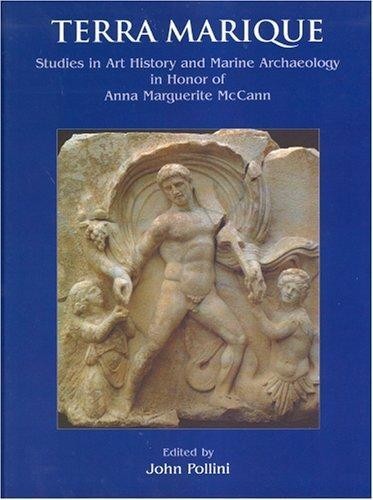
Format: Hardback
Pages: 304
ISBN: 9781842171486
Pub Date: 10 May 2005
Description:
In 1998 Anna Marguerite McCann received the Gold Medal of the Archaeological Institute of America for her distinguished archaeological achievements. This volume includes the papers presented at a special colloquium held in her honour, along with essays by other colleagues and friends. The volume is divided into two thematic parts: the first reflects Anna McCann's general interests in ancient art and archaeology, especially Greek and Roman sculpture; the other, her specific expertise in underwater and port archaeology and technology.
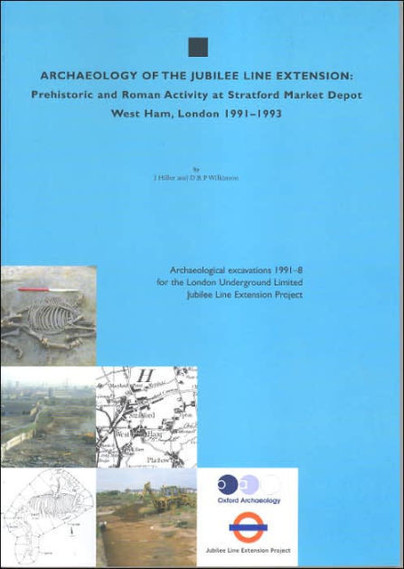
Format: Paperback
Pages: 56
ISBN: 9781901992540
Pub Date: 05 May 2005
Illustrations: 41 b/w illus
Description:
Excavation ahead of redevelopment by London Underground Limited uncovered flint tools and debitage characteristic of the Mesolithic and Neolithic periods and Early Bronze Age. Activity resumed in the Late Bronze Age. A neonate skeleton of Early Iron Age date was recovered from a rubbish pit near a probable roundhouse.
Two crouched adult inhumations are atypically early Roman. Two horse burials and a dog skeleton are also of Roman date. Thereafter, occupation ceased until post-medieval times. Overall, the work provides invaluable information relating to the development of the landscape beneath the suburbs of modern east London.
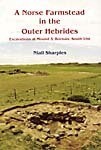
Format: Hardback
Pages: 224
ISBN: 9781842171691
Pub Date: 30 Apr 2005
Description:
This volume examines South Uist, a small island in the soutern half of the Outer Hebrides. In the middle of the island lies the township of Bornais. This covers a particularly flat area of land which means that the three mounds can be seen all the more clearly.
These mounds have been identified as being from the Viking period, with evidence of pre-Viking habitation at the site coming from Iron Age sherds. The excavation of the Bornais settlement is a long-term project, which has been going since 1994. This first volume of results of the excavation focuses on Mound 3, but includes a discussion of the topographic and geophysical survey of all the mounds. There is also considerable analysis of the environmental remains and radiocarbon dating.
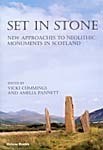
Format: Paperback
Pages: 128
ISBN: 9781842171431
Pub Date: 11 Mar 2005
Illustrations: b/w illus
Description:
As its title might suggest, this volume sets out to present a new view of Scotland's Neolithic as seen via its monumental structures. The papers brought together here came out of a research day at Cardiff University's School of History and Archaeology in January 2002 and cover a diverse number of topics. They raise questions of ancestry and worldview, and highlight the amount that can be done in examining the settings of monuments.

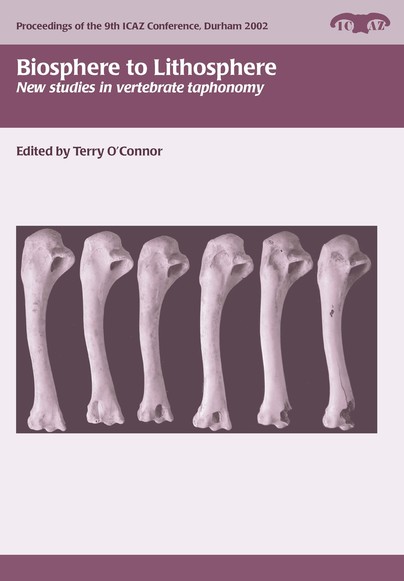
Pages: 176
ISBN: 9781842171189
Pub Date: 25 Feb 2005
Series: Proceedings of the 9th ICAZ Conference
Pages: 160
ISBN: 9781785704604
Pub Date: 15 Oct 2016
Series: Proceedings of the 9th ICAZ Conference
Description:
Taphonomic studies are a major methodological advance, the effects of which have been felt throughout archaeology. Zooarchaeologists and archaeobotanists were the first to realise how vital it was to study the entire process of how food enters the archaeological record, and taphonomy brought to a close the era when the study of animal bones and plant remains from archaeological sites were regarded mainly as environmental indicators.This volume is indicative of recent developments in taphonomic studies: hugely diverse research areas are being explored, many of which would have been totally unforeseeable only a quarter of a century ago.
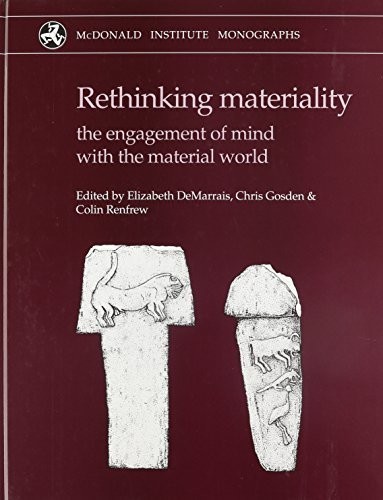
Format: Hardback
Pages: 280
ISBN: 9781902937304
Pub Date: 31 Jan 2005
Series: McDonald Institute Monographs
Illustrations: 62 ills., 3 tables
Description:
What is the relationship between mind and ideas on the one hand, and the material things of the world on the other? In recent years, researchers have rejected the old debate about the primacy of the mind or material, and have sought to establish more nuanced understandings of the ways humans interact with their material worlds. In this volume alternative approaches are presented, deriving from a wide variety of theoretical perspectives.
Contributors debate the significance of key thresholds in the human past, including sedentism, domestication, and the emergence of social inequality and their impact on changing patterns of human cognition, symbolic expression, and technological innovation. In its global coverage and its broad theoretical scope, this landmark volume offers an innovative and comprehensive assessment of current thinking and future directions.
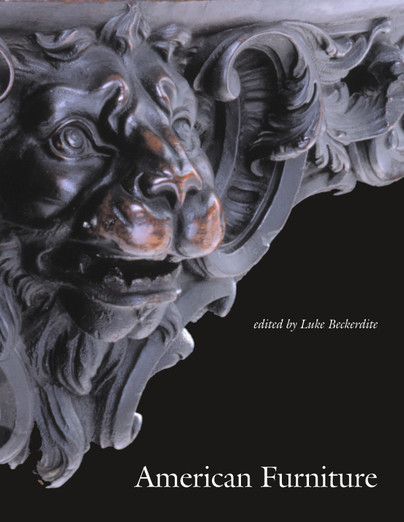
Format: Paperback
Pages: 316
ISBN: 9780972435345
Pub Date: 20 Jan 2005
Series: American Furniture Annual
Illustrations: 308 illus. (230 colour). 10 fig. Table. End-paper
Description:
Acknowledged as the journal of record in its field, American Furniture presents new research on furniture design, use, production, and appreciation. Begun in 1993, this award-winning annual provides a comprehensive forum on furniture history, technology, connoisseurship, and conservation by the foremost scholars in the field. It is the only interdisciplinary journal devoted exclusively to furniture made or used in the Americas from the 17th century to the present.
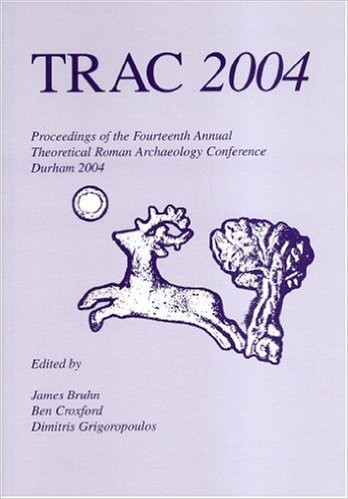
Format: Paperback
Pages: 170
ISBN: 9781842171738
Pub Date: 01 Jan 2005
Series: TRAC
Illustrations: b/w illus, tables
Description:
The fourteenth Theoretical Roman Archaeology Conference was held at the University of Durham Department of Archaeology, March 2004. The papers present and discuss information drawn from as wide a range of geographical regions of the Roman Empire as the scope of theoretical and methodological approaches applied. An equally wide selection of subject matter is illustrated, including the ancient economy, historiography and modern perceptions of the Roman world, production, supply and consumption of material culture, social identities and the experience of social space and the landscape.
Contents: Preface; The economy of Roman Britain: Representation and historiography (Kevin Greene) ; Reconstructing syntheses in Romano-British cremation (Jake Weekes) ; Metalworking and Late Roman power: A Study of towns in Later Roman Britain (Adam Rogers) ; Not at random: Evidence for a regionalized coin supply? (Fleur Kemmers) ; Regional identities and the social use of ceramics (Martin Pitts) ; Social and economic aspects of glass recycling (Daniel Keller) ; Interaction and exchange in food production in the Nijmegen frontier area during the Early Roman period (Annemiek Robeerst) ; Brickworks and ladders: Explaining intra-regional diversity of late prehistoric and Roman landscapes in the territory of the Parisi (Mick A Atha) ; Beyond the temple: Blurring the boundaries of 'sacred space' (Eleanor Ghey) ; The cupae of Iberia in their monumental contexts: A study of the relationship between social status and commemoration with barrel-shaped and semi-cylindrical tombstones (Charlotte Tupman) ; The quick and the dead in the extra-urban landscape: The Roman cemetery at Ostia/ Portus as a lived environment (E J Graham) ; Houses, GIS and the micro-topology of Pompeian domestic space (Michael A Anderson) ; Unifying aspects of Roman fortresses (Mark Driessen) .


















